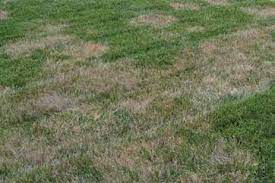Brown Patch of Tall Fescue

This fungal disease is very common on tall fescue lawns during Kansas summers. The disease-causing fungus becomes very active when conditions are moist and nighttime temperatures are above 65 degrees with the dew and high humidity. Unfortunately, with our recent rains and high temperatures we have had ideal conditions for brown patch to invade the lawns. In our area July and August are usually the worst for the disease for this reason. Brown patch symptoms typically develop within a couple days during the warm, humid weather of the summer. The patches start out as a dark purple-green but then quickly fade to light tan or brown as the diseased leaves die out. The turf may appear drought stressed even when the soil is still damp. The pattern of the damage is variable, as seen in the photo above with some places having distinct patches up to several feet in diameter and others having irregular/diffused blighting.
The pathogen typically infects the foliage and causes tan lesions or leaf spots with a brown border. This can help you identify if it’s brown patch or another issue. Some cultural treatments include not watering in the evening, don’t over fertilize and if you are overseeding don’t use high rates. While homeowner fungicides are available, there are mixed reviews if they are effective while commercial fungicides are more effective. The grass usually recovers when cooler temperatures encourage the grass to grow in September.
leaf spots with a brown border. This can help you identify if it’s brown patch or another issue. Some cultural treatments include not watering in the evening, don’t over fertilize and if you are overseeding don’t use high rates. While homeowner fungicides are available, there are mixed reviews if they are effective while commercial fungicides are more effective. The grass usually recovers when cooler temperatures encourage the grass to grow in September.

Have questions? Contact our office where our Horticulture Extension Agent will assist you with questions.
Phone: (316) 321-9660
Email: callae@ksu.edu